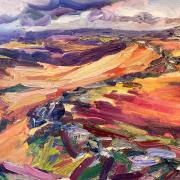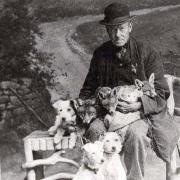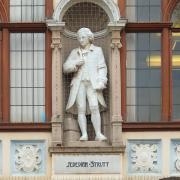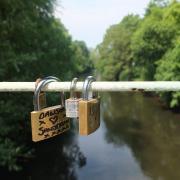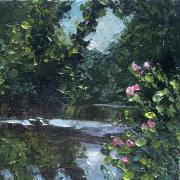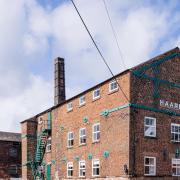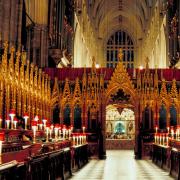Having worked at Chatsworth for 40 years Christine Robinson has a career lifetime of fascinating stories to relate. Deborah Barham Smith reports

Christine Robinson applied for her first summer job at Chatsworth in 1974. Then on finishing university, she was offered a year’s work – she stayed for forty.
For the last eight years of her time at ‘the jewel in the Peak District’s crown’ Christine was Head Housekeeper and responsible for the areas in the House visited by the public – working for both the 11th and the present 12th Duke of Devonshire. She has brought together her memories of life at the unique house (with the approval of the 12th Duke), in a fascinating opus: Chatsworth, the Housekeeper’s Tale. Not only does the impeccably researched book tell her story, it portrays the Devonshire dynasty in the historical context of our times.
Calling on Christine at her lovely home, Norman Villa, in the estate village of Edensor, she mentions that her links to the estate go back even further. She discovered that not only was the house one she visited as a child but it was originally built for her husband’s great, great grandfather.
A housekeeper is defined as a person, often hired, who performs or directs the domestic work and planning necessary for a home, such as cleaning or buying food. What an understatement in the case of a stately home, let alone one par excellence such as Chatsworth.

Christine says, ‘When I first told my family that I would be doing a demonstration about housekeeping, Michael, aged eight at the time, looked perplexed and said, “But there’s nothing to it, Mum! You just pick up a duster and find someone to give it to!”’ That could be many people’s perspective on a housekeeper’s role but her book tells of a whole other world.
Although Christine’s job was indeed cleaning the house and the shop and ticket sales office to start with, it expanded as Chatsworth grew. While still a fairly new employee she was tasked with taking a very precious cargo of Old Master drawings to America. She very modestly remarks that it was because no-one else was available, but considering the enormous monetary and historical value of these items, it says a lot about the trust in which she was held.
Forty years is a long time and Christine has many entertaining anecdotes to tell. In one she recalls a time the housekeeping team was involved in preparing for a charity event: ‘I remember a rehearsal many years ago when Holymoorside Choral Society was giving a concert in aid of Guide Dogs for the Blind. The rehearsal was going well, but there was a constant tapping that was decidedly off-beat. The conductor called the choir to order and asked whoever was tapping to stop, as they were out of time. The rehearsal began again, accompanied by the irritating tapping, and when the conductor stopped the rehearsal again, the tapping continued. Then he realised that it was the guide dog sitting with one of the singers, vigorously wagging its tail against the metal balustrade!’
It is obvious that Christine had a close association with Deborah, the late Dowager Duchess, who she says was very forward thinking and open to innovation. She recounts a fascinating glimpse into the Devonshires’ family life: ‘In her memoirs, Deborah Devonshire describes how her father-in-law, the 10th Duke, was an expert fly-tier, and explains his method like this: “Once the flies were ready, he lay in the bath imagining he was a salmon, while Edward, the butler, pretending to be a fishing rod, jerked them over his submerged head. The ones the Duke judged to be the most attractive were used on his stretch of the Blackwater River in County Cork at the start of the salmon fishing season.”’

Other interesting stories concern Chatsworth: ‘The painted ceiling in the Great Chamber was painted in 1691–2 by Antonio Verrio, and depicts the Return of the Golden Age, with Vices destroyed by their opposing Virtues, which was a reference to the blessings of the reign of William and Mary. One of the three Fates, Atropos, seen cutting the thread of life with her shears is, in the reality, the portrait of the first Duke’s housekeeper, Mrs Hackett, with whom Verrio was at odds, although no one knows why!’
Christine also recalls that after its refurbishment: ‘The Great Dining Room looked absolutely stunning... and when the house reopened an American visitor was overheard remarking to her husband, “I don’t often say this Sam, but when I look at this table, I feel quite outclassed!”’
Asked for her most unforgettable memory, she recalls a challenging occasion that also involved the Great Dining Room: ‘In 1994, His Grace decided to invite friends to dine at Chatsworth, with 34 to be seated at the dining table. At that time the table in the private dining room was unable to accommodate that number of guests, so His Grace, ever mindful of not wanting to make extra work for his staff, asked if we would be able to do something for him in the Great Dining Room, although he knew that the table in the Great Dining Room was not large enough either. However, underneath the Theatre stairs were the leaves and base of a spare table that was considerably longer, so we fetched it out to have a look at it. Two days before the dinner party, the joiners and housemen assembled the table in the Painted Hall before the visitors arrived, that being the only indoor space large enough to house it, and Her Grace came along to see the work and to make sure that it was comfortable and at the right height. Once the table passed muster, it was taken down, polished, and moved to the Great Dining Room, replacing the existing table.
‘We knew that the old tablecloth from the Great Dining Room was neither long enough nor wide enough and as Her Grace was keen that the cloth should hang nearly to the floor, we laid two identical cloths on the table and overlapped them. Then the lightest amongst us crawled the length of the table stitching the two cloths together. Once that was done, another cloth was laid over the top of them both to hide the join, and then Stella Mellors, the private housekeeper, and Barbara Burchby, the gardens’ secretary, stitched swags of ivy around the table sides. Next the table had to be laid, and the unfortunate silver steward, Ian Fraser-Martin, had to try to reach the centre of the table to place the enormous silver candelabra in position. White socks were quickly found for him so that he could pad about on the top of the table in his stocking feet to position the heavy silver with his customary precision.

‘Finally, the gardeners brought in a magnificent potted vine as a centrepiece. It was planted in a huge moss-covered pot and the gardeners tied extra bunches of grapes onto it with raffia. Her Grace was so excited with the effect that she sent for His Grace’s sister, Lady Elizabeth Cavendish, to come across from Edensor to view the table. The table looked truly magnificent. The lucky guests dined from Sèvres porcelain for the first course, silver for the main course, and Berlin china and gold plate for the pudding.’ A more different scenario to TV dinner on a tray in front of Corrie can hardly be imagined!
Christine’s tremendous respect for the Devonshires runs throughout the book. As she says, “They’re a lovely family to work for and very much involved in the community. The current Duke and Duchess have introduced many innovations since they took over in 2004, moving the House firmly into the 21st century.’ Christine asked the present Duke to read the draft of her book and was delighted when he said, ‘I thought I would just read the first chapter and the last chapter but I’ve been late going to bed, I couldn’t put it down!’
Christine had kept meticulous notes on everyday work events during her working career. She says: ‘I kept a work diary of special events right from the beginning because it’s surprising how quickly you forget. I partly did it for the sake of my two boys, because it’s something I wish my grandmother had done. I go out and give a lot of talks and people would often say that they hoped I was writing everything down, so I thought maybe it would be of interest to people. It was quite daunting to start with – just the decision whether to write it chronologically or by subject matter was difficult.’
Writing the book began over ten years ago but it was only after knee surgery and an enforced rest about four years ago that Christine got everything together and really made inroads. Once she’d begun in earnest though she recalls that she even begrudged going on holiday with her family because it was taking her away from ‘her baby’. ‘Once the book was done, there was a hole and that’s when you start worrying about it,’ says Christine. Well she certainly need not have done – it is a wonderful volume and, in company with the Duke of Devonshire, I couldn’t put it down. The other good news is that she has now started work on her next book – due to be published later this year.







